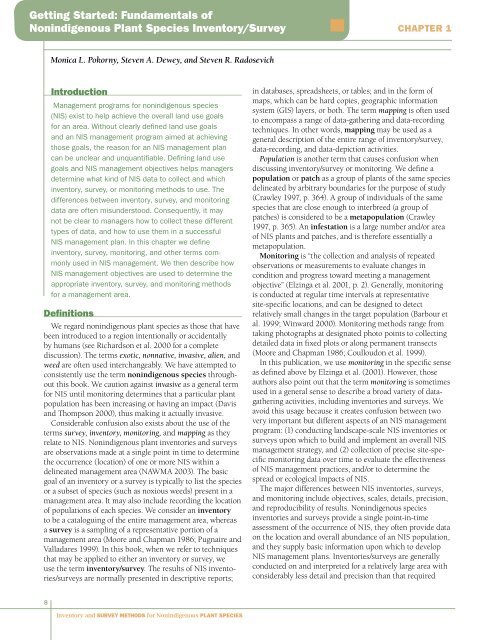Inventory and Survey Methods for Nonindigenous Plant Species (PDF)
Inventory and Survey Methods for Nonindigenous Plant Species (PDF)
Inventory and Survey Methods for Nonindigenous Plant Species (PDF)
- No tags were found...
Create successful ePaper yourself
Turn your PDF publications into a flip-book with our unique Google optimized e-Paper software.
Getting Started: Fundamentals of<strong>Nonindigenous</strong> <strong>Plant</strong> <strong>Species</strong> <strong>Inventory</strong>/<strong>Survey</strong>Chapter 1Monica L. Pokorny, Steven A. Dewey, <strong>and</strong> Steven R. RadosevichIntroductionManagement programs <strong>for</strong> nonindigenous species(NIS) exist to help achieve the overall l<strong>and</strong> use goals<strong>for</strong> an area. Without clearly defined l<strong>and</strong> use goals<strong>and</strong> an NIS management program aimed at achievingthose goals, the reason <strong>for</strong> an NIS management plancan be unclear <strong>and</strong> unquantifiable. Defining l<strong>and</strong> usegoals <strong>and</strong> NIS management objectives helps managersdetermine what kind of NIS data to collect <strong>and</strong> whichinventory, survey, or monitoring methods to use. Thedifferences between inventory, survey, <strong>and</strong> monitoringdata are often misunderstood. Consequently, it maynot be clear to managers how to collect these differenttypes of data, <strong>and</strong> how to use them in a successfulNIS management plan. In this chapter we defineinventory, survey, monitoring, <strong>and</strong> other terms commonlyused in NIS management. We then describe howNIS management objectives are used to determine theappropriate inventory, survey, <strong>and</strong> monitoring methods<strong>for</strong> a management area.DefinitionsWe regard nonindigenous plant species as those that havebeen introduced to a region intentionally or accidentallyby humans (see Richardson et al. 2000 <strong>for</strong> a completediscussion). The terms exotic, nonnative, invasive, alien, <strong>and</strong>weed are often used interchangeably. We have attempted toconsistently use the term nonindigenous species throughoutthis book. We caution against invasive as a general term<strong>for</strong> NIS until monitoring determines that a particular plantpopulation has been increasing or having an impact (Davis<strong>and</strong> Thompson 2000), thus making it actually invasive.Considerable confusion also exists about the use of theterms survey, inventory, monitoring, <strong>and</strong> mapping as theyrelate to NIS. <strong>Nonindigenous</strong> plant inventories <strong>and</strong> surveysare observations made at a single point in time to determinethe occurrence (location) of one or more NIS within adelineated management area (NAWMA 2003). The basicgoal of an inventory or a survey is typically to list the speciesor a subset of species (such as noxious weeds) present in amanagement area. It may also include recording the locationof populations of each species. We consider an inventoryto be a cataloguing of the entire management area, whereasa survey is a sampling of a representative portion of amanagement area (Moore <strong>and</strong> Chapman 1986; Pugnaire <strong>and</strong>Valladares 1999). In this book, when we refer to techniquesthat may be applied to either an inventory or survey, weuse the term inventory/survey. The results of NIS inventories/surveysare normally presented in descriptive reports;in databases, spreadsheets, or tables; <strong>and</strong> in the <strong>for</strong>m ofmaps, which can be hard copies, geographic in<strong>for</strong>mationsystem (GIS) layers, or both. The term mapping is often usedto encompass a range of data-gathering <strong>and</strong> data-recordingtechniques. In other words, mapping may be used as ageneral description of the entire range of inventory/survey,data-recording, <strong>and</strong> data-depiction activities.Population is another term that causes confusion whendiscussing inventory/survey or monitoring. We define apopulation or patch as a group of plants of the same speciesdelineated by arbitrary boundaries <strong>for</strong> the purpose of study(Crawley 1997, p. 364). A group of individuals of the samespecies that are close enough to interbreed (a group ofpatches) is considered to be a metapopulation (Crawley1997, p. 365). An infestation is a large number <strong>and</strong>/or areaof NIS plants <strong>and</strong> patches, <strong>and</strong> is there<strong>for</strong>e essentially ametapopulation.Monitoring is “the collection <strong>and</strong> analysis of repeatedobservations or measurements to evaluate changes incondition <strong>and</strong> progress toward meeting a managementobjective” (Elzinga et al. 2001, p. 2). Generally, monitoringis conducted at regular time intervals at representativesite-specific locations, <strong>and</strong> can be designed to detectrelatively small changes in the target population (Barbour etal. 1999; Winward 2000). Monitoring methods range fromtaking photographs at designated photo points to collectingdetailed data in fixed plots or along permanent transects(Moore <strong>and</strong> Chapman 1986; Coulloudon et al. 1999).In this publication, we use monitoring in the specific senseas defined above by Elzinga et al. (2001). However, thoseauthors also point out that the term monitoring is sometimesused in a general sense to describe a broad variety of datagatheringactivities, including inventories <strong>and</strong> surveys. Weavoid this usage because it creates confusion between twovery important but different aspects of an NIS managementprogram: (1) conducting l<strong>and</strong>scape-scale NIS inventories orsurveys upon which to build <strong>and</strong> implement an overall NISmanagement strategy, <strong>and</strong> (2) collection of precise site-specificmonitoring data over time to evaluate the effectivenessof NIS management practices, <strong>and</strong>/or to determine thespread or ecological impacts of NIS.The major differences between NIS inventories, surveys,<strong>and</strong> monitoring include objectives, scales, details, precision,<strong>and</strong> reproducibility of results. <strong>Nonindigenous</strong> speciesinventories <strong>and</strong> surveys provide a single point-in-timeassessment of the occurrence of NIS, they often provide dataon the location <strong>and</strong> overall abundance of an NIS population,<strong>and</strong> they supply basic in<strong>for</strong>mation upon which to developNIS management plans. Inventories/surveys are generallyconducted on <strong>and</strong> interpreted <strong>for</strong> a relatively large area withconsiderably less detail <strong>and</strong> precision than that required<strong>Inventory</strong> <strong>and</strong> <strong>Survey</strong> <strong>Methods</strong> <strong>for</strong> <strong>Nonindigenous</strong> <strong>Plant</strong> <strong>Species</strong>
















